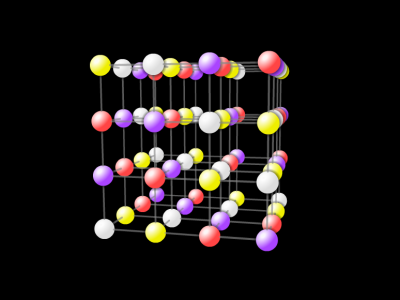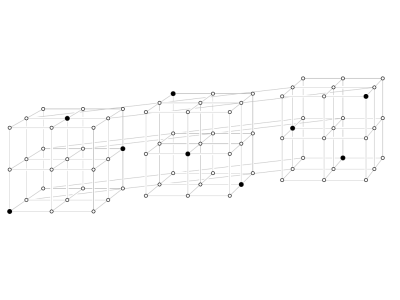Graeco-Latin cubes

- Citation Author(s):
- Submitted by:
- Denis Krotov
- Last updated:
- DOI:
- 10.21227/xh3k-pv95
- Data Format:
- Links:
 478 views
478 views
- Categories:
- Keywords:
Abstract
A Latin square of order q is a q×q array with elements from {0,1,...,q-1} such that each value occurs exactly once in each row and column. Two Latin squares G and L are orthogonal if (G(x,y), L(x,y)) = (u,v) has exactly one solution for each (u,v) from {0,1,...,q-1}×{0,1,...,q-1}. The square obtained by superimposing two orthogonal Latin squares to get entries with pairs of elements is called a Graeco-Latin square. A Latin cube of order q and is a q×q×q array with elements from {0,1,...,q-1} such that when any two coordinates are fixed, each element of {0,1,...,q-1} occurs exactly once. Two Latin cubes are orthogonal if fixing any coordinate gives a Graeco-Latin square when the cubes are superimposed. The cube obtained by superimposing two orthogonal Latin cubes is called a Graeco-Latin cube. Graeco-Latin cubes are equivalent to orthogonal arrays OA(q^3,5,q,2) or to (5,q^3,3)q codes, q-ary unrestricted (not necessarily linear or additive) MDS codes of length 5 and minimum distance 3. Two standard methods to construct Graeco-Latin cubes are the following:
(i) if q is a prime power larger than 3, than a q×q×q Graeco-Latin cube can be constructed as a Reed-Solomon code over the finite field GF(q);
(ii) from a q'×q'×q' Graeco-Latin cube and a q''×q''×q'' Graeco-Latin cube, we can construct a q'q''×q'q''×q'q'' Graeco-Latin cube by Cartesian product.
It is easy to see that with only these two constructions one cannot construct a Graeco-Latin cube of order 2p, where p is odd, or 3p, where p is not divisible by 3. In https://doi.org/10.1002/jcd.21718 , there is a construction that allows to construct Graeco-Latin cubes of order 3p for some p not divisible by 3. This dataset contains examples of Graeco-Latin cubes of first few orders such that Graeco-Latin cubes of the same order cannot be constructed as a Reed-Solomon code or by Cartesian product from cubes of smaller orders.
Instructions:
The archives are *.zip, but the algorithm is LZMA. If unzip does not work, use 7z:
7z e filename.zip
A cube of order q is saved in a archived text file with q*q*q lines. A line number q*q*x+q*y+z contains the two values in the cell (x,y,z) of the Graeco-Latin cube, in the hexadecimal format.
Dataset Files
- Graeco-Latin cube of order 84 (Size: 151.96 KB)
- Graeco-Latin cube of order 132 (Size: 559.12 KB)
- Graeco-Latin cube of order 276 (Size: 2.71 MB)
- Graeco-Latin cube of order 372 (Size: 5.45 MB)
- Graeco-Latin cube of order 516 (Size: 32.52 MB)
- Graeco-Latin cube of order 564 (Size: 16.94 MB)
- Graeco-Latin cube of order 660 (Size: 20.91 MB)
- Graeco-Latin cube of order 852 (Size: 49 MB)
- Graeco-Latin cube of order 948 (Size: 62.06 MB)







